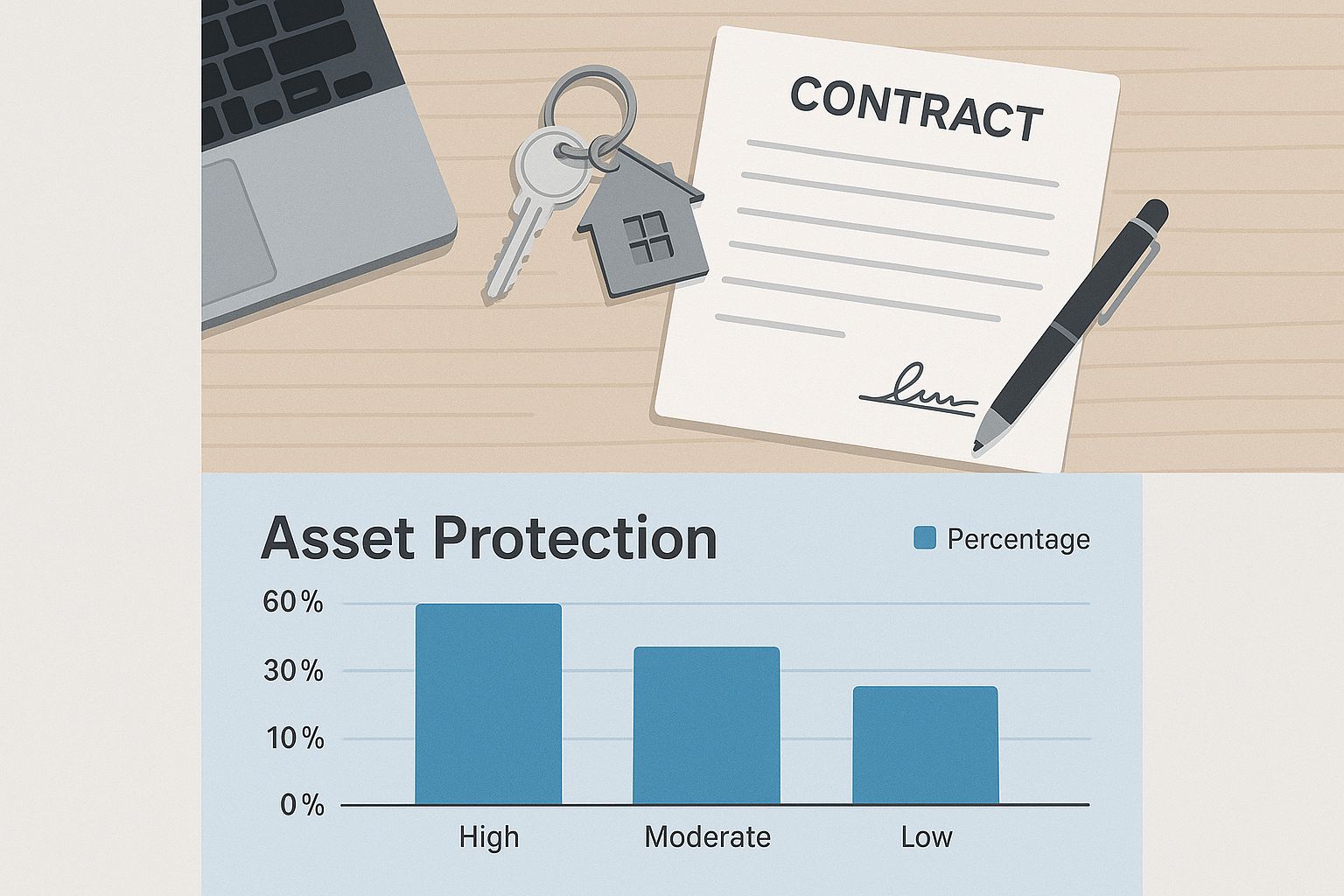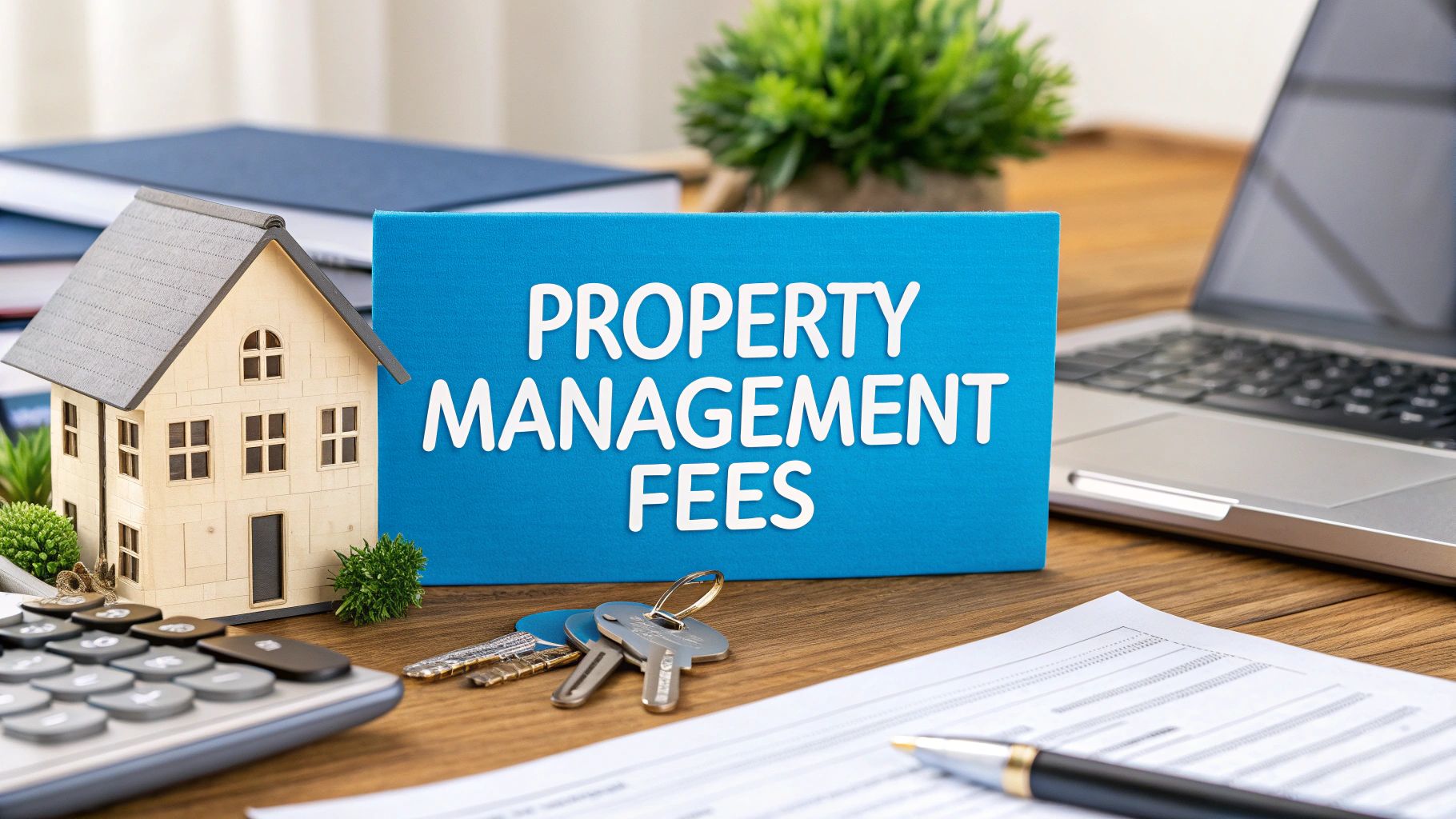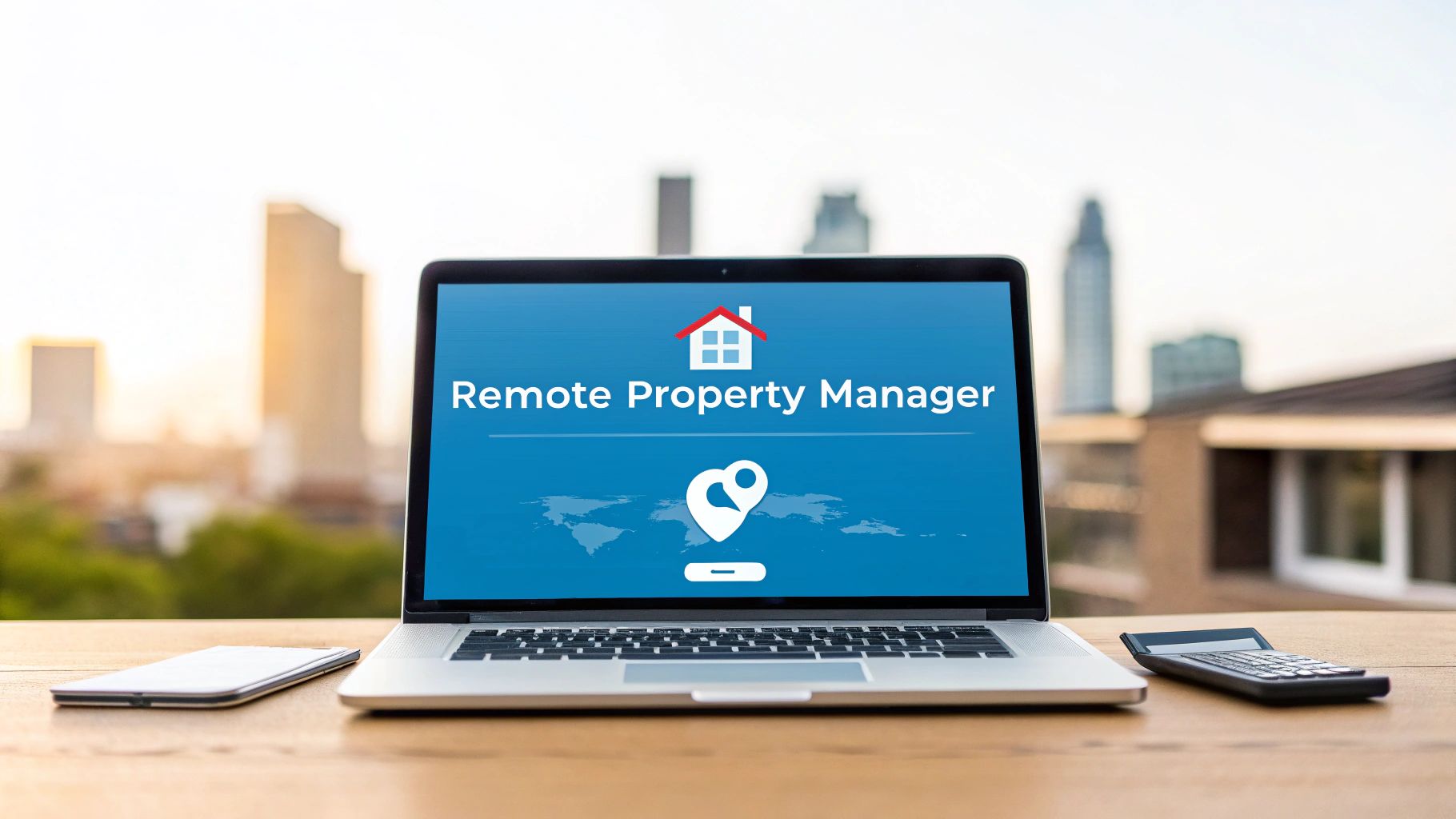At its core, a property management fee is what a management company charges to handle the day-to-day operations of a rental portfolio. For large-scale operators, this fee is a critical component of the cost-per-door analysis, covering essentials like rent collection, tenant relations, maintenance coordination, and financial reporting.
This isn’t just an expense; it’s an investment in operational efficiency, tenant retention, and asset protection across a distributed portfolio.
Understanding the Core Cost of Portfolio Management
When managing hundreds or even thousands of units, the management fee becomes a pivotal metric in your operational budget. The strategic approach is to view it not as a simple line item but as an investment in scalable, remote-first operational excellence.
This fee directly funds the systems, technology, and personnel required to keep properties leased, reduce vacancy loss, and maintain asset quality—all crucial for maximizing portfolio-wide returns.
The infographic below illustrates how this fee forms the foundation for protecting and enhancing your investment at scale.

It’s a clear reminder that you’re not just paying a bill—you’re strategically allocating capital to preserve and grow the value of your entire portfolio through efficient management.
What the Fee Typically Covers
While specifics vary, most standard agreements bundle crucial operational tasks. For single-family and smaller multifamily portfolios, property management fees typically range between 8% and 12% of the monthly collected rent. The most common rate for full-service management is 10%.
This fee underpins a scalable, remote-first operation. For a deeper dive into what goes into managing a property, especially in different niches, checking out a comprehensive guide to managing vacation rental property can provide valuable foundational context.
So, what does this investment actually buy? Here's a breakdown of the standard services usually covered by the monthly fee.
Standard Services Covered by Monthly Management Fees
This table outlines the typical day-to-day tasks included in a standard management fee, which are essential for remote property management operations.
These are the fundamentals that keep properties profitable and well-maintained without requiring on-site staff.
Understanding these core services is key. As you explore different management options, you’ll see how various pricing structures are built around these functions and how each model can impact your portfolio's bottom line.
Breaking Down the Common Fee Structures
Choosing the right property management fee structure isn't just a financial decision—it's a strategic one that influences your manager's incentives and your portfolio's performance. For operators managing hundreds or thousands of doors, the choice between the two main models, percentage-based and flat-fee, dictates how costs scale with your portfolio.
Each model has distinct advantages and disadvantages that must be weighed against your operational goals and financial metrics.
The Percentage-Based Model
This is the most prevalent model in the industry. The property management company takes a percentage of the monthly rent collected, typically between 8% to 12%. The key benefit of this model is the alignment of incentives.
Since the manager’s income is directly tied to your rental revenue, they are financially motivated to secure the highest possible rent and minimize vacancy days. This shared-risk, shared-reward system creates a partnership focused on maximizing asset performance.
This structure is particularly effective in markets with rising rents. As your revenue grows, so does their compensation, encouraging proactive lease renewals and diligent market analysis.
The downside? For high-rent properties, this model can become expensive. A 10% fee on a $3,000/month luxury unit is significantly more than on a $1,500/month apartment, even if the operational workload is similar. This can create budget unpredictability at scale. It is also critical to understand what services, like those for managing lease agreements, are included to ensure the value aligns with the cost.
The Flat-Fee Model
Conversely, the flat-fee model offers predictability. You pay a fixed dollar amount per unit each month, regardless of the rent collected.
This consistency is a major advantage for large-scale operators who rely heavily on precise cost-per-door metrics for financial forecasting. It ensures management costs remain stable, even if a unit is temporarily vacant.
However, the incentive alignment is less direct. A manager on a flat fee lacks the immediate financial motivation to push for higher rents or reduce Days on Market (DOM), as their compensation remains the same. Their focus may shift from revenue maximization to operational efficiency and cost containment.
ROI Calculation Example: Imagine you have a 500-unit portfolio with an average rent of $2,000.
- Under a 10% percentage model, your annual management cost is $1,200,000.
- With a $150 flat fee per unit, the annual cost is $900,000.
That $300,000 difference forces a critical question: Do you believe the percentage model's incentive structure will generate more than $300,000 in additional rental income through superior leasing performance and DOM reduction?
Ultimately, the decision depends on your portfolio strategy. For aggressive growth and revenue optimization, the percentage model may be ideal. For predictable costs and stable operations in mature markets, the flat-fee structure provides unmatched budget clarity.
Uncovering Additional Management Fees
The monthly management fee is just the starting point. For large portfolios, the true cost of management is often found in the ancillary fees detailed in the fine print of the agreement. These charges can significantly impact profitability and must be factored into any cost-per-door analysis.
These fees typically cover specific, event-driven services that fall outside of routine day-to-day management. Understanding them is essential for optimizing costs and maintaining financial predictability across a large number of units.

Common Fees Beyond the Standard Rate
While your core management fee covers occupied units, a different set of costs emerges during tenant turnover, lease renewals, or evictions. These fees compensate your manager for the significant effort involved in marketing a vacancy, screening applicants, negotiating renewals, or handling legal proceedings.
For portfolio operators, each ancillary fee represents a variable cost that must be tracked. A seemingly minor charge can become a substantial expense when multiplied across a portfolio with a standard turnover rate.
Key Insight: A comprehensive cost analysis must model both fixed monthly fees and variable ancillary charges. A low base management rate can be misleading if it is accompanied by high, frequent additional fees that inflate your total cost of management.
Let's examine the most common ancillary fees you're likely to encounter.
Common Ancillary Property Management Fees Breakdown
The table below details typical fees charged in addition to the standard monthly rate, clarifying their purpose and cost structure.
This is not an exhaustive list, but it covers the major fees that can significantly affect your portfolio's financial performance.
Strategic Negotiation for Large Portfolios
As an enterprise-level operator, you possess significant negotiating leverage. While many focus on the base management percentage, substantial savings can be achieved by negotiating or capping these ancillary fees.
For example, consider a 500-unit portfolio with a 20% annual turnover. Negotiating a reduced tenant placement fee from 100% down to 75% of the first month's rent could save tens of thousands of dollars annually. Similarly, capping maintenance markups ensures that large capital projects do not incur excessive administrative charges.
The objective is not to eliminate all fees but to achieve full transparency. Your management agreement must clearly define every potential charge, enabling accurate financial forecasting and protecting your portfolio's ROI. For property management at scale, this level of detail is non-negotiable.
How Your Market and Portfolio Size Affect Fees
Property management fees are not static; they are influenced by local market conditions and, critically, by the scale of your portfolio. While factors like geography and property type set a baseline, for managers of large portfolios, understanding how size creates leverage is key to securing optimal pricing.

It is logical that a manager in a high-cost urban market will command a higher fee than one in a lower-cost rural area. Similarly, managing a scattered portfolio of single-family homes is more logistically intensive—and therefore more expensive per unit—than managing a single, large multifamily building.
However, for operators at scale, the most powerful negotiating tool is portfolio size itself.
The Power of Economies of Scale
As you add more doors, you unlock significant negotiating power through economies of scale. A management company can service 1,000 units with greater per-door efficiency than they can 10 units, thanks to streamlined processes and centralized operations. This efficiency gain should translate into a lower per-unit rate for you.
This principle is a fundamental driver of the property management industry. The global property management market, valued at USD 26.13 billion in 2023, is projected to grow to USD 53.07 billion by 2032, driven by the expansion of rental portfolios and the need for scalable solutions.
The implication is clear: scale drives efficiency, and efficiency should reduce your per-unit costs.
Key Takeaway for Large Portfolios: Never accept a standard, one-size-fits-all fee structure. Your scale is your greatest asset in any negotiation. Frame the discussion around the operational efficiencies and predictable revenue your portfolio provides, which justifies a lower per-door cost.
Benchmarking Your Current Fee Structure
To determine if your fees are optimized, you must benchmark them against the market. This requires a value-based assessment, not just a simple comparison of percentages.
A Strategic Framework for Analyzing Your Fees:
- Market Analysis: Solicit proposals from several management companies to establish the typical fee ranges for portfolios of your size and type in your specific markets.
- Service Level Audit: Evaluate whether your current fee aligns with the technology and operational speed you receive. A manager who consistently reduces your Days on Market (DOM) may justify a higher fee by directly increasing your revenue.
- Cost-Benefit Calculation: Quantify the financial impact of your manager's performance. Calculate the additional revenue generated from rapid leasing and low vacancy rates, and weigh it against the fees paid.
This framework shifts the conversation from "What is the cost?" to "What is my ROI?". Exploring the future of property management can provide insights into how technology is reshaping efficiency, helping you ensure your fees are optimized for peak performance.
Optimizing Fees for Maximum Portfolio ROI
For large-scale portfolios, focusing solely on the lowest property management fee is a common and costly error. True optimization is not about minimizing a line-item expense but about maximizing portfolio-wide ROI. The critical question must shift from, "Who offers the cheapest rate?" to "Which fee structure and management partner delivers the highest net return?"
This requires connecting management costs directly to key performance indicators (KPIs). A low-cost manager who allows a unit to sit vacant for 45 days is far more expensive than a premium, tech-enabled manager who leases it in 15. The most significant cost is not the fee itself, but the lost revenue from operational friction and prolonged vacancy.
A Value-Based Approach to Fee Analysis
Focusing on a single percentage point is a tactical oversight. A value-based analysis delves deeper, evaluating how a manager's operational capabilities impact your most critical leasing metrics: Days on Market (DOM) and lead-to-tour conversion rates.
A higher fee often represents an investment in superior systems, automation, and speed-to-lease. These are the tools that combat vacancy loss—the single largest threat to profitability for any large portfolio. According to the 2024 State of the Property Management Industry Report, nearly 70% of property managers are focused on growth, with technology and efficiency being top priorities for achieving it.
Mini Case Study: Calculating the Real Cost of Vacancy
Let's quantify the financial impact. Imagine a 500-unit portfolio with an average rent of $2,000/month. The annual turnover rate is 20%, meaning 100 units require leasing each year.
You are comparing two management options:
- Manager A (Low-Cost): Charges an 8% management fee and a 75% leasing fee. Their average DOM is 35 days.
- Manager B (Tech-Enabled): Charges a higher 10% management fee and a 100% leasing fee. However, their automated systems and on-demand showings reduce average DOM to just 15 days.
Now, let's calculate the revenue impact of the additional 20 days of vacancy under Manager A:
Vacancy Cost Calculation:
Daily Rent: $2,000 / 30 days = $66.67 per day
Additional Vacancy Cost Per Unit: 20 days x $66.67 = $1,333.40
Total Annual Vacancy Loss (100 units): 100 x $1,333.40 = $133,340
Despite higher stated fees, Manager B's superior speed-to-lease saves the portfolio over $133,000 in lost rent annually. This demonstrates that the manager who delivers the lowest DOM provides a far greater return, easily justifying a premium fee. This ROI-centric mindset is crucial for scaling profitably. For more strategies, see our guide on 8 powerful ways to boost your property management ROI.
Your Top Questions, Answered
For large portfolio operators, clarity on property management fees is essential for making informed decisions and negotiating effectively. Here are answers to the most common questions from enterprise-level property managers.
Is a Lower Management Fee Always Better for My Portfolio?
No. In fact, an unusually low fee can be a red flag, often indicating limited services, outdated technology, or an understaffed team. Initial savings are frequently negated by hidden costs like longer vacancy periods, inadequate tenant screening, and slow maintenance response times, all of which hurt your bottom line.
For a large portfolio, a slightly higher fee paid to a tech-forward manager who can demonstrably reduce your Days on Market and improve lead-to-tour conversion rates will almost always yield a superior ROI. The focus should be on the net value delivered, not just the percentage charged.
How Can I Negotiate Fees for a Large Portfolio?
Your portfolio's scale is your primary source of leverage. It offers a management company predictable revenue and operational efficiencies, and your pricing should reflect this value.
Use these negotiation tactics:
- Benchmark First: Obtain proposals from several qualified management companies to establish a clear market rate for a portfolio of your size and type.
- Focus on Ancillary Fees: Instead of fixating on the base management percentage, negotiate ancillary costs like leasing, renewal, and setup fees, where small reductions are amplified across your entire portfolio.
- Propose a Tiered Structure: Suggest a fee model where the per-unit rate decreases as you add more properties to their management.
- Frame it as a Partnership: Position the negotiation as the formation of a long-term strategic partnership where both parties benefit from operational efficiency and scale.
Key Negotiation Insight: When you bring hundreds or thousands of units to the table, you're not just another client; you're a strategic partner. Use this position to negotiate terms that reflect the value and scale you provide, ensuring the fee structure aligns with your long-term ROI goals.
What Hidden Fees Should I Look for in a Contract?
Thoroughly scrutinize the management agreement for any charges not explicitly discussed. A transparent contract will itemize every potential fee. If the language is ambiguous, demand clarification in writing before signing. Unforeseen costs can disrupt budgets and undermine profitability at scale.
Be vigilant for these common "hidden" fees:
- Maintenance markups
- Account setup or onboarding fees
- Technology or software platform fees
- Routine inspection charges
- Specific advertising or marketing costs
- Eviction service fees beyond standard court costs
Does the Management Fee Cover Placing a New Tenant?
Almost never. The monthly management fee typically covers the day-to-day operations for an occupied unit. The process of marketing a vacancy, managing showings, screening applicants, and executing a lease is covered by a separate leasing fee or tenant placement fee.
This is a one-time charge, usually between 50% and 100% of the first month's rent. Understanding this distinction is critical for accurately forecasting your total cost of ownership and the financial impact of tenant turnover across your portfolio.
Ready to see how automating your leasing process can drastically reduce vacancy costs and boost your portfolio's ROI? Showdigs combines AI-backed software with a network of on-demand agents to slash your Days on Market and convert leads into leases faster than ever.
Discover how Showdigs can optimize your leasing operations today.






